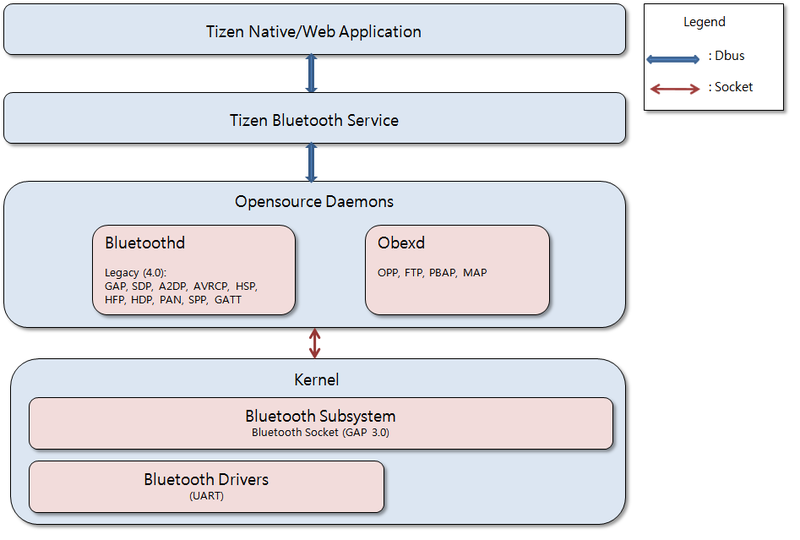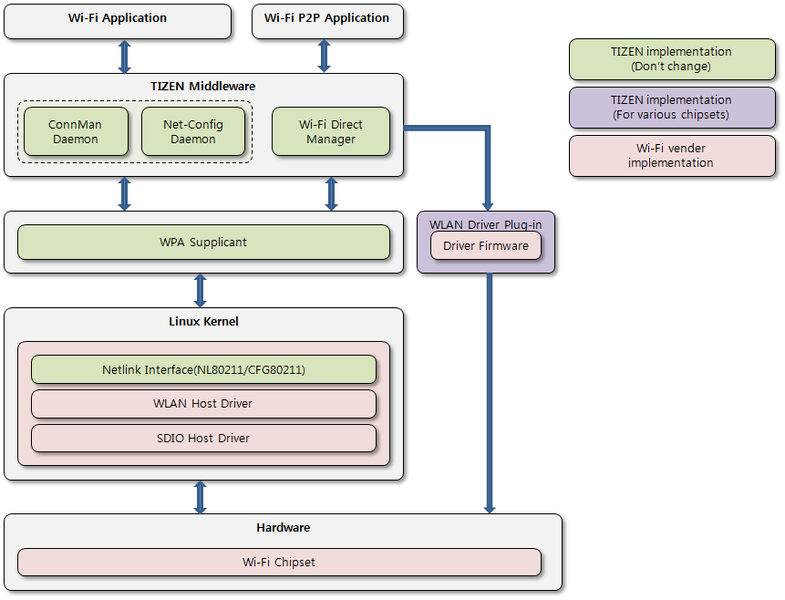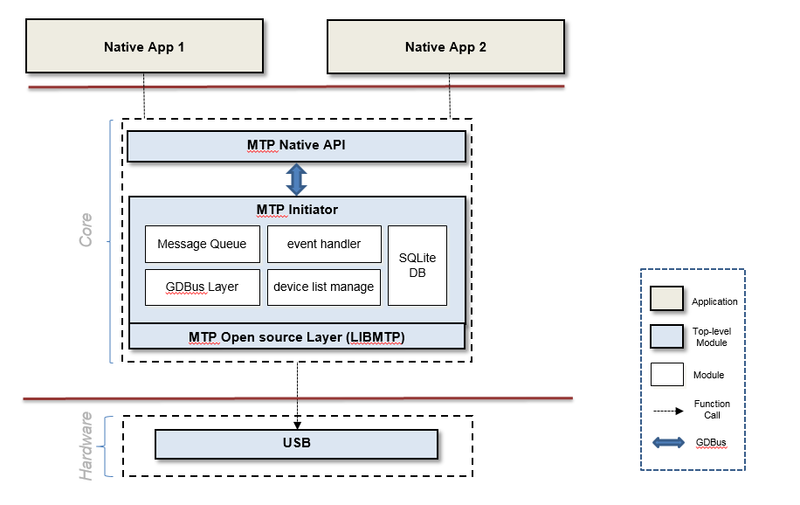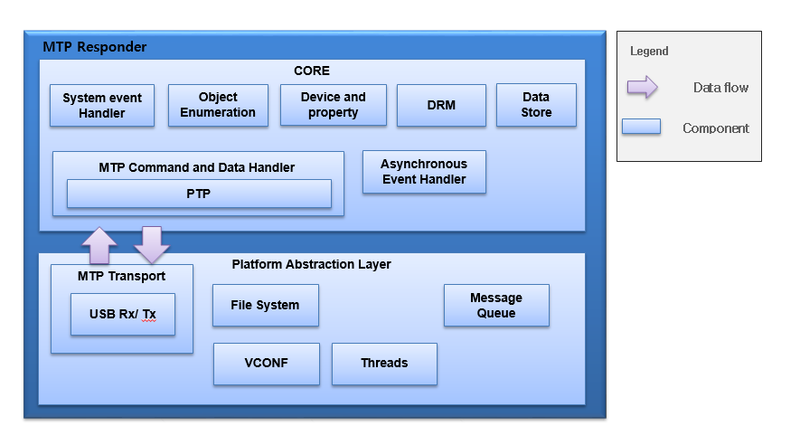Connectivity
You can implement various connectivity features, such as Bluetooth, WLAN, and NFC.
Bluetooth
Bluetooth is a short range communication protocol used to communicate between 2 devices. Tizen uses open source Bluetooth components, such as BlueZ and ObexD. Bluez and ObexD run as a daemon and an interface library, Bluetooth Framework, is used for applications to access them over the D-Bus interface.
This section explains the Bluetooth architecture on the Tizen platform and how Tizen can be ported, along with the configuration parameters and their values.
Figure: Tizen Bluetooth architecture

The Bluetooth framework provides a dialogue for the user to control the BlueZ, ObexD, and PulseAudio daemons. Bluetooth provides a standard interface between the Bluetooth chip and AP, called the HCI (Host Controller Interface). HCI can be implemented on USB, UART, and SDIO, but for the mobile environment, UART is the most common. HCI activation can differ depending on the chip vendor. The vendor provides the HCI configuration and the initial scripts. For example, Broadcom and Spreadtrum provide firmware and a loading tool. Tizen supports Bluetooth version 4.2, and the GATT, FTP, OPP, MAP, PBAP, A2DP, AVRCP, HSP/HFP, RFCOMM, HID, HDP, and PAN profiles. Bluetooth Low Energy functions have been implemented in BlueZ and bluetooth-frwk.
The Tizen Bluetooth framework is based on the open source BlueZ project. BlueZ provides the DBUS API and based on it, Tizen Bluetooth framework provides the C Language API. Using the Tizen Bluetooth framework is recommended.
The following components are necessary for Bluetooth:
- Application
- User dialogue that controls the BlueZ, ObexD, and PulseAudio daemons
- ObexD
- Open source component
- Object exchange daemon
- Supports OPP, FTP, PBAP, SYNC, and MAP profile stack
- BluetoothD
- BluetoothD is the open source component, BlueZ 5.37 is supported
- Bluetooth central daemon
- Supports GAP, SDP, A2DP, AVRCP, HFP, HSP, and GATT profile stack
- Bluetooth subsystem
- Provides the BT unix socket. Each protocol can be accessed by its socket.
- Supports the L2CAP, RFCOMM, SCO, and HCI protocols
- Bluetooth driver
- BT Chip driver
- For UART, the interface is provided by the Linux kernel.
- GPIO configuration,
rfkill(radio frequency management), and power management can be handled by both the vendor and the porting engineer
- Bluetooth firmware loading module
- Depending on the environment, it loads the Bluetooth firmware to the Bluetooth chip
- Tizen and the chipset vendor need to implement this together
- Package:
bluetooth-tools
Porting the OAL interface
The following OAL scripts are run during the Bluetooth stack start and end sequences. These scripts invoke the Bluetooth chip-specific (such as Broadcom and Spreadtrum) scripts, provided by the chipset vendor, to perform chip-specific configuration. These scripts are available in the bluetooth-dev-tools.under package. When this package is installed, it copies the following scripts in the /usr/etc/Bluetooth/ directory:
bt-stack-up.shbt-stack-down.shbt-reset-env.sh
Tizen BT Obex profiles
In Tizen, the open source ObexD is used for the obex-based profiles:
- BT Obex profiles server (
obexd) - BT Obex profiles client (
obex-client)
Configuration
There are a few configuration changes that need to be made to enable the specific chipset and the scripts and other chipset-specific configuration information, such as UART speed and UART terminal (tty). These changes must be provided by the chipset vendor.
- Configuration for the Broadcomm BCM4358 Bluetooth chipset:
hciattach
Thebluez/tools/hciattach.cfile is patched to enable thehciattachtool specific to the BCM4358 chipset. This service attaches the BT UART HCI interface to the Bluetooth stack at a baud rate of 3000000. It is also responsible for loading the Bluetooth firmware on BCM4358.- Bluetooth UART used is
/dev/ttySAC3 - Broadcom firmware used is
BCM4358A1_001.002.005.0032.0066.hcd - UART speed configuration for BCM4358A1 is 3000000
bcmtoolused isbcmtool_4358a1.bd_addrcontains the unique Bluetooth address, which is generated during the first Bluetooth activation- Register the Bluetooth device:
bcmtool_4358a1 /dev/ttySAC0 -FILE=BCM4358A1_001.002.005.0032.0066.hcd -BAUD=3000000 -ADDR=/csa/bluetooth/.bd_addr -SETSCO=0,0,0,0,0,0,0,3,3,0 -LP - Attach a serial device to the Bluetooth stack using the UART HCI for a Broadcomm device:
hciattach /dev/ttySAC3 -S 3000000 bcm2035 3000000 flow - Run the Bluetooth daemon version 5.37:
bluetoothd - Bring the device up, set up the device name, and enable the SSP mode:
hciconfig hci0 up hciconfig hci0 name "Tizen-Mobile" hciconfig hci0 sspmode 1 - Switch on the Bluetooth radio:
rfkill unblock bluetooth - Switch off the Bluetooth radio:
rfkill block bluetooth
- Configuration for the Spreadtrum sc2331 Bluetooth chipset
hciattach
Thebluez/tools/hciattach.cfile is patched to enable thehciattachtool specific to the sc2331 chipset. This service attaches the BT UART HCI interface to the Bluetooth stack at a baud rate of 3000000. It is also responsible for loading the Bluetooth firmware on sc2331.- Register the Bluetooth device:
Thecp2-downloadtool is provided for downloading the Spreadtrum firmware. This tool also downloads the Wi-Fi firmware at boot time. - Install the following files in the target’s
/usr/lib/firmwaredirectory:sc2331_fdl.bin sc2331_fw.bin scx35_pikeavivaltove_3M_MARLIN_connectivity_calibration.ini scx35_pikeavivaltove_3M_MARLIN_connectivity_configure.ini - Bluetooth UART used is
/dev/ttyS0 - UART speed configuration for sc233 is 3000000
- Attach a serial device to the Bluetooth stack using the UART HCI:
hciattach -s 3000000 /dev/ttyS0 sprd 3000000 flow - Run the bluetooth daemon version 5.37:
bluetoothd - Bring the device up, set up the device name, and enable the SSP mode:
hciconfig hci0 up hciconfig hci0 name "Tizen-Mobile" hciconfig hci0 sspmode 1
References
Open source component version: BlueZ 5.37
For more information, see http://www.bluez.org/.
The reference kernel configuration for Bluetooth:
- The following kernel
.configlines are enabled for Broadcom Bluetooth support:CONFIG_BT=y CONFIG_BT_L2CAP=y CONFIG_BT_RFCOMM=y CONFIG_BT_RFCOMM_TTY=y CONFIG_BT_BNEP=y CONFIG_BT_HIDP=y CONFIG_BT_HCIUART=y CONFIG_BT_HCIUART_H4=y CONFIG_BCM4330=y CONFIG_RFKILL=y CONFIG_RFKILL_INPUT=y CONFIG_RXTRA_FIRMWARE_BCM4330="BCM4330.hcd" - The following kernel
.configlines are enabled for Bluetooth AVRCP support:CONFIG_INPUT_MISC=y CONFIG_INPUT_UINPUT=y - The following kernel
.configlines are enabled for Bluetooth HID support:CONFIG_INPUT_GP2A=y CONFIG_INPUT_KR3DH=y - The following kernel
.configlines are enabled for Bluetooth Audio (SCO-over-PCM) support:CONFIG_BT_SCO=y CONFIG_INPUT_GP2A=y CONFIG_INPUT_KR3DH=y
WLAN
This section provides a step-by-step explanation of what is involved in adding a new Wi-Fi driver and making Wi-Fi work.
Figure: Tizen Wi-FI architecture

Feature overview:
- WLAN (802.11 b/g/n)
- WPS PBC
- EAP (PEAP, TTLS)
Tizen uses wpa_supplicant as the platform interface to Wi-Fi devices. Your Wi-Fi driver must be compatible with the standard wpa_supplicant.
The Tizen WLAN architecture is centered on the Linux wireless (IEEE-802.11) subsystem. The Linux wireless SW stack defines the WLAN hardware adaptation software interfaces that need to be used in Tizen. In practice, the required interfaces are defined by cfg80211 for FullMAC WLAN devices and by mac80211 for SoftMAC WLAN devices. In addition, a Linux network interface needs to be supported towards the Linux TCP/IP stack.
The Connection Manager (ConnMan) is a daemon for managing Internet connections within embedded devices running the Linux operating system.
The wpa_supplicant interface is a WPA Supplicant with support for WPA and WPA2 (IEEE 802.11i / RSN). WPA Supplicant is the IEEE 802.1X/WPA component that is used in the client stations. It implements key negotiation with a WPA Authenticator, and it controls roaming and the IEEE 802.11 authentication/association of the WLAN driver.
Porting the OAL interface
The WLAN driver plugin is specific to a Wi-Fi chipset. This includes firmware and chipset-specific tools. Wi-Fi chipset firmware and tool files must be copied to the WLAN driver plugin directory, built, and installed before testing the Wi-Fi functionality. Because of Tizen platform requirements, the Wi-Fi driver must create the /opt/etc/.mac.info file, which has the device MAC address.
The WLAN driver plugin contains the wlan.sh file (located in /usr/bin/wlan.sh), which is used to load or unload the Wi-Fi driver firmware.
When the wifi_activate() function is called, the load driver request is sent to the NET-CONFIG daemon. The NET-CONFIG daemon loads the Wi-Fi driver using the wlan.sh script file. Similarly, the wifi_deactivate() function requests unloading of the Wi-Fi driver. In case of Wi-Fi Direct®, the wifi_direct_activate() and wifi_direct_deactivate() functions make the Wi-Fi Direct manager load or unload the Wi-Fi driver using the wlan.sh script.
Using the /usr/bin/wlan.sh script:
wlan.sh start: Power up the Wi-Fi driver in station mode by loading the driver and running the firmware file.wlan.sh p2p: Power up the Wi-Fi driver in Wi-Fi Direct mode by loading the driver and running the firmware file.wlan.sh softap: Power up the Wi-Fi driver in Soft AP mode by loading the driver and running the firmware file.wlan.sh stop: Power down the Wi-Fi driver.
All other Wi-Fi related functionality is handled by the ConnMan daemon.
References
- Connection Manager (ConnMan) project website: https://01.org/connman
- Linux wireless (IEEE-802.11) subsystem: https://wireless.wiki.kernel.org
- Information on Linux WPA/WPA2/IEEE 802.1X Supplicant: http://hostap.epitest.fi/wpa_supplicant/
- Latest ConnMan release: http://git.kernel.org/?p=network/connman/connman.git;a=summary
- WLAN driver plugin Git path:
/adaptation/devices/wlandrv-plugin-tizen-bcm43xx - Reference kernel configurations
- The following options must be enabled if the driver supports the cfg802.11 configuration API, instead of the wireless extension API. For more information, see https://wireless.wiki.kernel.org:
CONFIG_CFG80211 CONFIG_LIB80211 CONFIG_MAC80211 (Enable this flag, if the driver supports the softMAC feature) - The following configuration options must be enabled in the kernel if the driver supports wireless extension APIs:
CONFIG_WIRELESS_EXT=y CONFIG_WEXT_CORE=y CONFIG_WEXT_PROC=y CONFIG_WEXT_PRIV=y CONFIG_WEXT_SPY=y CONFIG_WIRELESS_EXT_SYSFS=y
NFC
The NFC application enables the user to:
- Read and import the content written on an NFC tag.
- Edit the content written on an NFC tag.
- Write and save data on an NFC tag.
- Load and save the NFC data from or in a file.
Figure: NFC architecture

The NFC implementation has the following main components:
- NFC client acts as an interface between the NFC application and the NFC manager, while writing or editing tag information in any physical tag.
- NFC manager is the main interface, which actually deals with NFC physical tags, creates a connection with tags, and detects it. It is a daemon process to control the NFC chipset (such as NXP pn544). It provides the read and write service and basic P2P communication service, as well as the basic API for the client application.
- NFC stack contains the required plugin, based on the NFC chipset. Currently, the
nfc-plugin-nxpis used for the NXP chipset. The NFC plugin acts as an interface between the NFC chipset with the NFC framework (nfc-manager). It must be implemented according to the interface provided by thenfc-manager.
Porting the OAL interface
The NFC plugin is implemented as a shared library and it interfaces the Tizen nfc-manager and the vendor NFC chip. The NFC manager loads the libnfc-plugin.so library at runtime from the /usr/lib/libnfc-plugin.so directory. Any vendor-specific plugin is installed within the same path. The plugin must be written with predefined OAL API interfaces.
During initialization, the nfc-manager loads the nfc-plugin.so library, searches for the onload() function, and calls the function with an interface structure instance as an argument for mapping all the OAL interfaces. These OAL/OEM interfaces are implemented according to the underlying NFC chipset. Once the mapping is done, the NFC manager interacts with nfc-plugin, which implements the vendor-specific OAL interfaces.
The following example shows the onload() function:
Bool
onload(net_nfc_oem_interface_s *oem_interfaces) {
oem_interfaces->init = xxx; /* xxx refers to plugin APIs */
oem_interfaces->deinit = xxx;
oem_interfaces->register_listener = xxx;
oem_interfaces->unregister_listener = xxx;
oem_interfaces->check_firmware_version = xxx;
return true;
}
The NFC OAL interfaces are defined in the following structure. Use the net_nfc_oem_controller.h header file:
typedef struct _net_nfc_oem_interface_s {
net_nfc_oem_controller_init init;
net_nfc_oem_controller_deinit deinit;
net_nfc_oem_controller_register_listener register_listener;
net_nfc_oem_controller_unregister_listener unregister_listener;
net_nfc_oem_controller_check_firmware_version check_firmware_version;
net_nfc_oem_controller_update_firmware update_firmware;
net_nfc_oem_controller_get_stack_information get_stack_information;
net_nfc_oem_controller_configure_discovery configure_discovery;
net_nfc_oem_controller_get_secure_element_list get_secure_element_list;
net_nfc_oem_controller_set_secure_element_mode set_secure_element_mode;
net_nfc_oem_controller_connect connect;
net_nfc_oem_controller_connect disconnect;
net_nfc_oem_controller_check_ndef check_ndef;
net_nfc_oem_controller_check_target_presence check_presence;
net_nfc_oem_controller_read_ndef read_ndef;
net_nfc_oem_controller_write_ndef write_ndef;
net_nfc_oem_controller_make_read_only_ndef make_read_only_ndef;
net_nfc_oem_controller_transceive transceive;
net_nfc_oem_controller_format_ndef format_ndef;
net_nfc_oem_controller_exception_handler exception_handler;
net_nfc_oem_controller_is_ready is_ready;
net_nfc_oem_controller_llcp_config config_llcp;
net_nfc_oem_controller_llcp_check_llcp check_llcp_status;
net_nfc_oem_controller_llcp_activate_llcp activate_llcp;
net_nfc_oem_controller_llcp_create_socket create_llcp_socket;
net_nfc_oem_controller_llcp_bind bind_llcp_socket;
net_nfc_oem_controller_llcp_listen listen_llcp_socket;
net_nfc_oem_controller_llcp_accept accept_llcp_socket;
net_nfc_oem_controller_llcp_connect_by_url connect_llcp_by_url;
net_nfc_oem_controller_llcp_connect connect_llcp;
net_nfc_oem_controller_llcp_disconnect disconnect_llcp;
net_nfc_oem_controller_llcp_socket_close close_llcp_socket;
net_nfc_oem_controller_llcp_recv recv_llcp;
net_nfc_oem_controller_llcp_send send_llcp;
net_nfc_oem_controller_llcp_recv_from recv_from_llcp;
net_nfc_oem_controller_llcp_send_to send_to_llcp;
net_nfc_oem_controller_llcp_reject reject_llcp;
net_nfc_oem_controller_llcp_get_remote_config get_remote_config;
net_nfc_oem_controller_llcp_get_remote_socket_info get_remote_socket_info;
net_nfc_oem_controller_sim_test sim_test;
net_nfc_oem_controller_test_mode_on test_mode_on;
net_nfc_oem_controller_test_mode_off test_mode_off;
net_nfc_oem_controller_support_nfc support_nfc;
} net_nfc_oem_interface_s;
The nfc_oem_interface_s struct is exported in the nfc-plugin. Using this interface structure, the nfc-manager communicates with the OAL interfaces at runtime. The NFC plugin loads when the nfc-manager is started and the plugin init() function is called to initialize the NFC chip:
int (*init) (net_nfc_oem_controller_init*);
The nfc-manager issues the deinit() function to deinitialize the NFC chip:
int (*deinit) (net_nfc_oem_controller_deinit *);
Pay attention to the following:
- Sending the notification to the upper layer (NFC service)
See thephdal4nfc_message_glib.cfile. Theg_idle_add_fullis used for handling the message in the NFC service. You can use the callback client asynchronously in the client context. Post a message in queue, and the message is processed by a client thread. - Reference implementation of the NFC plugin
Sample code snippets cannot be reproduced. Code is proprietary. For reference, see thenfc-plugin-emulandnfc-plugin-nxpfiles.
NFC OAL API
The following table lists all the NFC OAL API functions.
Table: NFC OAL API functions
| Function | Description | Parameter |
|---|---|---|
net_nfc_oem_controller_init init; |
Initializes the NFC chip. | net_nfc_error_e: Returns an error code on failure |
net_nfc_oem_controller_deinit deinit; |
Deinitializes the NFC chip. | - |
net_nfc_oem_controller_register_listener register_listener; |
Registers a callback function for a tag event, SE event, and llcp event. | target_detection_listener_cb target_detection_listener: Tag event callback functionse_transaction_listener_cb se_transaction_listener: SE event callback functionllcp_event_listener_cb llcp_event_listener: llcp event callback functionnet_nfc_error_e: Returns an error code on failure |
net_nfc_oem_controller_unregister_listener unregister_listener; |
Releases a callback function for a tag event, SE event, and llcp event. | - |
net_nfc_oem_controller_check_firmware_version check_firmware_version; |
Checks the firmware version of the NFC chip. | net_nfc_error_e: Returns an error code on failure |
net_nfc_oem_controller_update_firmware update_firmware; |
Updates the NFC chip firmware. | net_nfc_error_e: Returns an error code on failure |
net_nfc_oem_controller_get_stack_information get_stack_information; |
Gets the list of supported tags and the current firmware version. | net_nfc_stack_information_s: Pointer value to get the information of support tags and the current firmware versionnet_nfc_error_e: Returns an error code on failure |
net_nfc_oem_controller_configure_discovery configure_discovery; |
Delivers the config information on discovery. | net_nfc_discovery_mode_e: Start/stop modenet_nfc_event_filter_e config: Information for tag filteringnet_nfc_error_e: Returns an error code on failure |
net_nfc_oem_controller_get_secure_element_list get_secure_element_list; |
Gets the information of the current secure element. | net_nfc_secure_element_info_s: Pointer value to get secure element informationint: Pointer value to get the count of the secure elementnet_nfc_error_e: Returns an error code on failure |
net_nfc_oem_controller_set_secure_element_mode set_secure_element_mode; |
Sets the secure element to use. | net_nfc_secure_element_type_e: Secure element informationnet_nfc_secure_element_mode_e: Mode information to setnet_nfc_error_e: Returns an error code on failure |
net_nfc_oem_controller_connect connect; |
Connects to the detected tag/target. | net_nfc_target_handle_s: Tag/target handle for connectingnet_nfc_error_e: Returns an error code on failure |
net_nfc_oem_controller_connect disconnect; |
Disconnects the connected tag/target. | net_nfc_target_handle_s: Tag/target handle for disconnectingnet_nfc_error_e: Returns an error code on failure |
net_nfc_oem_controller_check_ndef check_ndef; |
Checks the tag for ndef support. | net_nfc_target_handle_s: Tag handle to check ndefint: Max size supported in the tagint: Real data size saved in the tagnet_nfc_error_e: Returns an error code on failure |
net_nfc_oem_controller_check_target_presence check_presence; |
Checks whether a tag exists in the RF range. | net_nfc_target_handle_s: Tag handle to check presencenet_nfc_error_e: Returns an error code on failure |
net_nfc_oem_controller_read_ndef read_ndef; |
Reads ndef data in a tag. | net_nfc_target_handle_s: Tag handle to readdata_s: Pointer value to save the ndef datanet_nfc_error_e: Returns an error code on failure |
net_nfc_oem_controller_write_ndef write_ndef; |
Writes the data to the tag. | net_nfc_target_handle_s: Handle to writedata_s: Data to writenet_nfc_error_e: Returns an error code on failure |
net_nfc_oem_controller_make_read_only_ndef make_read_only_ndef; |
Makes the tag to a read-only tag. | net_nfc_target_handle_s: Target tag handlenet_nfc_error_e: Returns an error code on failure |
net_nfc_oem_controller_transceive transceive; |
Sends and receives the low command to the tag or target. | net_nfc_target_handle_s: Tag or target handle to transceivenet_nfc_transceive_info_s: Pointer value including command or data to send and data to receivedata_s: Pointer value to send the information of contextnet_nfc_error_e: Returns an error code on failure |
net_nfc_oem_controller_format_ndef format_ndef; |
Formats the tag. | net_nfc_target_handle_s: Tag handle to formatdata_s: Key value to send the tag for formattingnet_nfc_error_e: Returns an error code on failure |
net_nfc_oem_controller_exception_handler exception_handler; |
When the nfc-manager faces an unwanted exception, it tries to deinitialize and initialize the stack before unregistering and registering the callback function. |
- |
net_nfc_oem_controller_is_ready is_ready; |
Checks the status of the NFC stack. | net_nfc_error_e: Returns an error code on failure |
net_nfc_oem_controller_llcp_config config_llcp; |
Sets the llcp configuration (miu, lto, wks, option). | net_nfc_target_handle_s: Target handle to set llcpnet_nfc_error_e: Returns an error code on failure |
net_nfc_oem_controller_llcp_check_llcp check_llcp_status; |
Checks the llcp configuration (miu, lto, wks, option). | net_nfc_target_handle_s: Target handle to check llcpnet_nfc_error_e: Returns an error code on failure |
net_nfc_oem_controller_llcp_activate_llcp activate_llcp; |
Activates the llcp functionality. | net_nfc_target_handle_s: Target handle to activatenet_nfc_error_e: Returns an error code on failure |
net_nfc_oem_controller_llcp_create_socket create_llcp_socket; |
Creates the llcp socket. | net_nfc_llcp_socket_t: Pointer value to receive the socket informationnet_nfc_socket_type_e socketType: Type of socket to createuint16_t miu: miu valueuint8_t rw: rw valuenet_nfc_error_e: Returns an error code on failurevoid: value to control the context (can be set to NULL) |
net_nfc_oem_controller_llcp_bind bind_llcp_socket; |
Binds the socket. | net_nfc_llcp_socket_t socket: Information about the socket to binduint8_t service_access_point: Information of access point to bindnet_nfc_error_e: Returns an error code on failure |
net_nfc_oem_controller_llcp_listen listen_llcp_socket; |
Sets the socket to listen. | net_nfc_target_handle_s: Target handleuint8_t: Service name to listennet_nfc_llcp_socket_t socket: Socket informationnet_nfc_error_e: Returns an error code on failurevoid: Value to control the context (can be set to NULL) |
net_nfc_oem_controller_llcp_accept accept_llcp_socket; |
Accepts the connect request in listening status. | net_nfc_llcp_socket_t socket: Socket information to acceptnet_nfc_error_e: Returns an error code on failure |
net_nfc_oem_controller_llcp_connect_by_url connect_llcp_by_url; |
Connects the server with the service name. | net_nfc_target_handle_s: Handle of the target to connectnet_nfc_llcp_socket_t socket: Socket informationuint8_t: Service name to connectnet_nfc_error_e: Returns an error code on failurevoid: Value to control the context (can be set to NULL) |
net_nfc_oem_controller_llcp_connect connect_llcp; |
Connects to the server with access point (port number). | net_nfc_target_handle_s: Target handlenet_nfc_llcp_socket_t socket: Socket informationuint8_t service_access_point: Access point numbernet_nfc_error_e: Returns an error code on failurevoid: Value to control the context (can be set to NULL) |
net_nfc_oem_controller_llcp_disconnect disconnect_llcp; |
Disconnects the llcp link. | net_nfc_target_handle_s: Socket information to disconnectnet_nfc_llcp_socket_t socket: Information of the socket to disconnectnet_nfc_error_e: Returns an error code on failurevoid: Value to control the context (can be set to NULL) |
net_nfc_oem_controller_llcp_socket_close close_llcp_socket; |
Closes the llcp socket. | net_nfc_llcp_socket_t socket: Socket information to closenet_nfc_error_e: Returns an error code on failure |
net_nfc_oem_controller_llcp_recv recv_llcp; |
Receives the data using the llcp link. | net_nfc_target_handle_s: Target handle to receivenet_nfc_llcp_socket_t socket: Socket information to receivedata_s: Pointer value to receive the datanet_nfc_error_e: Returns an error code on failurevoid: Value to control the context (can be set to NULL) |
net_nfc_oem_controller_llcp_send send_llcp; |
Sends the data using llcp link. | net_nfc_target_handle_s: Target handle to sendnet_nfc_llcp_socket_t socket: Socket information to senddata_s: Data to sendnet_nfc_error_e: Returns an error code on failurevoid: Value to control the context (can be set to NULL) |
net_nfc_oem_controller_llcp_recv_from recv_from_llcp; |
Rejects the connect request from the client socket. | net_nfc_target_handle_s: Target handle to rejectnet_nfc_llcp_socket_t socket: Socket information to rejectnet_nfc_error_e: Returns an error code on failure |
net_nfc_oem_controller_llcp_send_to send_to_llcp; |
Sends the data using the service access point. | net_nfc_target_handle_s: Peer target handlenet_nfc_llcp_socket_t socket: Socket informationdata_s: Data to senduint8_t service_access_point: Service access point to sendnet_nfc_error_e: Returns an error code on failurevoid: Value to control the context (can be set to NULL) |
net_nfc_oem_controller_llcp_reject reject_llcp; |
Rejects the connect request from the client socket. | net_nfc_target_handle_s: Target handle to rejectnet_nfc_llcp_socket_t socket: Socket information to rejectnet_nfc_error_e: Returns an error code on failure |
net_nfc_oem_controller_llcp_get_remote_config get_remote_config; |
Gets the llcp socket config information of the peer device. | net_nfc_target_handle_s: Peer target handlenet_nfc_llcp_config_info_s: Pointer value to get config information of peer device’s llcp socketnet_nfc_error_e: Returns an error code on failure |
net_nfc_oem_controller_llcp_get_remote_socket_info get_remote_socket_info; |
Gets the llcp socket information of the peer device. | net_nfc_target_handle_s: Peer target handlenet_nfc_llcp_socket_t socket: llcp socket informationnet_nfc_llcp_socket_option_s: Pointer value to save the information of remote socketnet_nfc_error_e: Returns an error code on failure |
net_nfc_oem_controller_sim_test sim_test; |
Tests the SWP link with SIM and NFC chipset. | net_nfc_error_e: Returns an error code on failure |
net_nfc_oem_controller_test_mode_on test_mode_on; |
Changes the NFC chip to test mode. (Test mode exists only in the NXP case. If there are none, it does not need to implemented.) | net_nfc_error_e: Returns an error code on failure |
net_nfc_oem_controller_test_mode_off test_mode_off; |
Changes the status of the NFC chip from test mode to normal mode. (Test mode exists only in the NXP case. If there are none, it does not need to implemented.) | net_nfc_error_e: Returns an error code on failure |
net_nfc_oem_controller_support_nfc support_nfc |
Checks each device file of each chip. | - |
Configuration
The nfc-plugin package must be saved to the /usr/lib/libnfc-plugin.so directory when installed. When the nfc-manager starts, it looks for the plugin library and loads it dynamically from this path.
References
Enable the following configuration options in the kernel .config file:
Using Pn544: CONFIG_PN544_NFC
Using Pn65n: CONFIG_PN65N_NFC
API references are available in the Tizen 3.0 Porting Guide appendix.
For more information, see http://nfc-forum.org/.
MTP
The Media Transfer Protocol (MTP) is used for exchanging media files between 2 devices:
-
MTP exchanges can only occur between 2 devices at a time.
-
In each communication, 1 devices acts as the initiator and the other as the responder.
-
The initiator is the device that initiates actions with the responder by sending operations to the responder.
Figure: MTP Initiator

-
The responder cannot initiate any actions, and can only send responses to operations sent by the initiator or send events.
Figure: MTP Responder

-
In the Tizen system, the USB host is the initiator, and the USB device is the responder.
Porting the OAL interface
The Tizen MTP initiator and responder do not have an OAL Interface. There are extension possibilities for the MTP Transport layer.
Configuration
The following configuration is needed:
- MTP initiator
- The MTP Initiator consists of 3 packages:
mtp-initiator daemon mtp-initiator api libmtp opensource - The MTP initiator does not operate independently. It requires the help of another module, such as USB.
- When the USB device is connected to the host, the module must run the MTP initiator daemon.
- The MTP Initiator consists of 3 packages:
- MTP responder
- The MTP responder consists of 1 package:
mtp-responder daemon - The MTP responder does not operate independently. It requires the help of another module, such as USB.
- When the USB device is connected to the host, the module must run the MTP responder daemon.
- The MTP responder consists of 1 package:
References
- Media Transfer Protocol v.1.1 Spec: http://www.usb.org/developers/docs/devclass_docs/